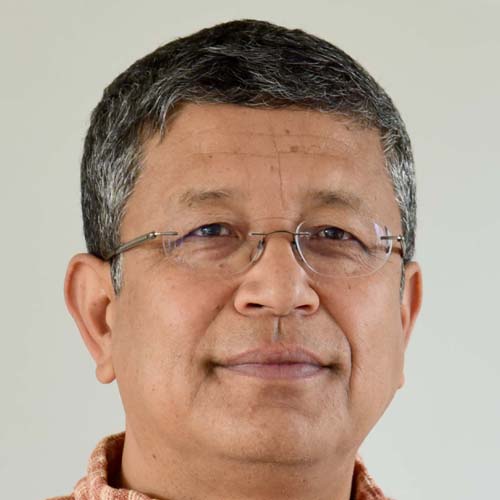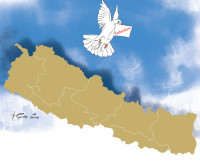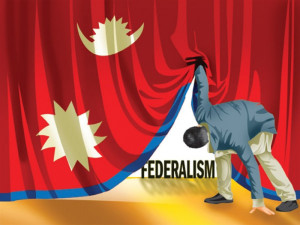Columns
The unfortunate dismissal of gender equality
Although the government does have social inclusion provisions, they are largely ignored or purposefully ridiculed.
Deepak Thapa
When I saw a news report with the title, ‘Employment for the husband to look after son’, I had hoped against hope that it would somehow not be limited only to snide swipes on the waste of public resources. That it would attempt to spark a conversation on the practical difficulties faced by working women. That it would try to generate some discussion on how far short our legal regime, as well as everyday practices, fall in recognising the needs specific to a full half of the population. My hope was expectedly belied since the journalist appeared interested only in ferreting out any whiff of irregularities.
The story was about Sushma Chaudhary, Deputy Mayor of Bansgadhi Municipality in Bardiya District, and her husband, Mangal. When elected in 2017, Deputy Mayor Chaudhary’s son was just three months old. In the apparent absence of any kind of support system in her office, she created the position of a personal secretary and appointed her hubby to the post in order to take care of her child. A photograph shows the little boy’s cot in the deputy mayor’s office while the rest of the article lapsed into a ‘she-said, he-said’ narrative, where Chaudhary defended her decision and her own municipal officials cast doubt on the legality of the arrangement. The reporter did admit that the deputy mayor was clear about her plans: ‘[Our] son will turn three next year and go to school. Mangalji will then lose his job.’
In order to gauge readers’ reactions, I scanned through the comments section. There were a few ruing of what appears to be a case of clear nepotism, with one reader even advising the deputy mayor to quit her job if she cannot look after the baby herself. Thankfully, there was another that accused the journalist of being heartless and simply asked how else was the deputy mayor supposed to take care of her child.
Contrast that with what happened at the UN General Assembly in 2018. When Jacinda Ardern, the prime minister of New Zealand, took her daughter to the UN General Assembly, photos of the two of them and her partner seated with the country’s official contingent made headlines around the world. Ardern was rightly hailed for taking that historic step on behalf of working mothers, and her partner, Clarke Gayford, was called a model father. Ardern made it clear that all expenses for Gayford’s trip were paid personally. As a professional in his own right in a developed country, perhaps Gayford does not require any other incentive than the pleasure of looking after their daughter. That can hardly be the case with Mangal Chaudhary even though we were not informed about the financial status of the Chaudhary couple. But, legal arguments aside, one can argue that the salary that comes by serving as an assistant to his wife perhaps makes up for the opportunity cost, i.e., the potential income he would have lost, as a result of taking care of their son and allowing the deputy mayor to focus fully on her official duties.
Whither GESI
What is surprising and distressing about the story is that it comes a whole decade after the Local Governance and Community Development Programme (LGCDP), which basically ran local governments prior to the 2017 elections, had adopted the Gender Equality and Social Inclusion Operational Strategy. One would have assumed LGCDP would have put in place a system that would make life easier for working mothers like Deputy Mayor Chaudhary, especially since it had been known since the adoption of the 2015 Constitution that women would make up at least 40 percent of the elected officials in the local government.
This brings us to the idea of Gender Equality and Social Inclusion, or GESI, as it is commonly known. An innovation that is wholly Nepali in origin and thus far the only country that has adopted the concept at the government level, the GESI approach resulted at a particular juncture in our history that recognised the Maoist and other associated conflicts to have resulted from age-old exclusionary practices of the state. As a result, ‘inclusion’ became the byword for all that ails Nepali society and politics. The government’s Three-Year Interim Plan (2007-08–2009-10) has perhaps one of the most succinct articulations on what inclusion is all about: ‘Inclusion means to fulfil the physical, emotional and basic needs of all the people, groups or castes. It has to be achieved by respecting their dignity and their own culture and also reducing the disparities between excluded and advantaged groups and by reducing the gap in the existing opportunities and access. In addition to this, it is to help to build a just society by ensuring rightful sharing of power and resources for their active participation as a citizen.’
Unfortunately, identity politics took centre-stage in the years after 2006, dealing a staggering blow to the idea of inclusion itself. Despite a lot of evidence to the contrary, the traditionally powerful groups were able to tar inclusion itself as something instigated by donors. But, since inequality was, and still is, defined very much by one’s group identity, a fact that continues to be proven by various studies year after year, it was not something that could easily be ignored by anyone. Particularly by the government if foreign funds were being sought for the development enterprise. The compromise was GESI, and at present, there is hardly any government programme that does not have a GESI component, and certainly none which have been funded by donors.
The acceptability of GESI to those in power was mainly because it appears to focus on ‘gender equality’ instead of the more threatening ‘social inclusion’. Indeed, the former has often been achieved at the cost of the latter. Yet, even gender equality is far from being achieved in government practice. Let us take one example. When the Labour Act of 2017 was enacted, prominently missing was a very progressive provision from the 1992 Labour Act that decreed a crèche or playroom in workplaces with more than 50 women under the supervision of a trained nurse, and where women could nurse their babies. Of course, none of the three pre-2006 parliaments had 50 women MPs for the act to be invoked, and since the 2017 Act is now operational, the current Parliament is not required to set aside such a facility even though the Lower House has 90 women members. But, even when the 1992 Act was in force at the time of both the Constituent Assemblies, with a full one-third of the 600-odd members being women, no thought seems to have ensured that the honourable female members could be near their little ones. We could certainly do with a bit of GESI in the legislative branch, whether it received foreign funding or not.
GESI and GESA
I end with a short anecdote, from a western Nepal district, that has stayed with me for some years. I was visiting the implementing partner of a government agency that was pretty well known for its successful GESI policy, funded as it was by a consortium of donors. I had remarked on the fortuitous circumstance of finding the GESI officer there to be a male, a rarity since that role is almost always taken up by, or rather given to, women. The GESI officer took my comment in his stride but said it is not always easy. He talked about being ribbed by senior officials in the Kathmandu headquarters of the government agency, who took to calling them ‘gesa’, a play on ‘keta’, the Nepali term for a boy, in contradistinction to ‘gesi’, with its connotation in their minds of ‘keti’, or girl. The name of the organisation is not important since it is not the organisational culture that is to blame but the overall attitude towards the idea of inclusion, whether gender or social.




 9.12°C Kathmandu
9.12°C Kathmandu

.jpg&w=200&height=120)











%20(1).jpg&w=300&height=200)

